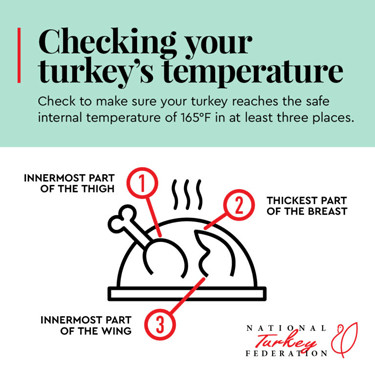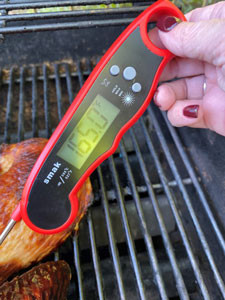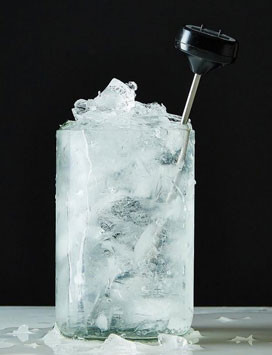Ensuring your turkey is cooked to the perfect temperature is crucial for both safety and taste. Knowing where to accurately check the temperature is just as important as having a good thermometer. Are you unsure Where To Test Turkey Temperature to guarantee a juicy, safe, and delicious Thanksgiving or holiday centerpiece? This guide will walk you through the essential steps to confidently measure your turkey’s internal temperature, ensuring a perfectly cooked bird every time.
Why Accurate Turkey Temperature Readings Matter
Cooking a turkey isn’t just about following a recipe; it’s about ensuring it reaches a safe internal temperature to eliminate harmful bacteria. The magic number you need to remember is 165°F (74°C). This temperature, as recommended by food safety experts and organizations like the USDA, is the minimum internal temperature required to kill bacteria like Salmonella and E. coli, making your turkey safe to eat.
Beyond food safety, accurate temperature readings are also key to achieving a moist and tender turkey. Overcooked turkey is dry and tough, while undercooked turkey is unsafe and unappetizing. By precisely measuring the temperature in the right spots, you can pull your turkey out of the oven at the peak of perfection, ensuring a flavorful and enjoyable meal for everyone.
 Checking turkey temperature in three locations – breast, thigh, and wing
Checking turkey temperature in three locations – breast, thigh, and wing
Key Locations for Thermometer Placement in Turkey
To get a truly accurate reading of your turkey’s internal temperature, you need to check it in multiple locations. This is because different parts of the turkey cook at different rates. Here are the three key areas to focus on when using your meat thermometer:
-
The Thickest Part of the Breast: This area tends to be the densest part of the turkey and takes the longest to heat up. Insert the thermometer into the thickest part of the breast, going in at an angle if necessary to avoid hitting the bone.
-
The Innermost Part of the Thigh: The thigh meat is darker and denser than the breast, and it’s crucial to ensure it reaches a safe temperature. Locate the innermost part of the thigh, which is the area closest to the body of the turkey. Insert the thermometer deep into the thigh, again being careful not to touch the bone.
-
The Innermost Part of the Wing: Similar to the thigh, the wing joint is another area that can be slow to cook. Insert the thermometer into the thickest part of the wing, close to the joint where it connects to the body.
Important Thermometer Placement Tips:
- Avoid Bone Contact: Make sure the tip of your thermometer is inserted into the meat and not touching bone or gristle. Bone conducts heat differently and can give you a falsely high reading, leading to undercooked turkey.
- Don’t Touch the Pan: Ensure the thermometer tip isn’t resting on the roasting pan, as this will also give you an inaccurate reading.
- Side Insertion for Breasts and Patties: When checking the temperature of turkey breasts or ground turkey patties, insert the thermometer from the side, horizontally. This provides a more accurate reading and is easier than trying to insert it from the top.
Understanding Internal Turkey Temperature
As mentioned earlier, the safe internal temperature for turkey is 165°F (74°C). This applies to all parts of the turkey – breast, thigh, and wing – as well as any stuffing you’ve cooked inside the turkey. It’s essential to check the temperature in all three locations to ensure the entire bird is safely cooked.
 Thermometer showing 165 degrees Fahrenheit in turkey thigh
Thermometer showing 165 degrees Fahrenheit in turkey thigh
The USDA and National Turkey Federation emphasize the importance of using a meat thermometer. Consumer research shows that meat thermometer ownership has increased, highlighting a growing awareness of food safety. Using a thermometer isn’t just a suggestion; it’s the best way to guarantee a safe and delicious turkey dinner.
Remember to also check your oven temperature for accuracy. An oven that is too hot or too cold can significantly impact cooking time and the quality of your turkey. A variance of even 25°F can affect the final outcome.
Choosing the Right Meat Thermometer for Turkey
Having the right tools makes all the difference in the kitchen, and a reliable meat thermometer is essential for cooking turkey. Here are several types of thermometers you can use:
Oven-Proof Thermometers
- How they work: These thermometers are designed to stay in the turkey throughout the cooking process. You insert them at the beginning, and they provide a continuous reading as the turkey cooks.
- Best for: Whole turkeys and turkey breasts.
- Pros: Hands-free monitoring, constant temperature display.
- Cons: Can be slower to register temperature changes compared to instant-read thermometers.
Instant-Read and Digital Thermometers
- How they work: These thermometers provide rapid and highly accurate temperature readings. They are not meant to stay in the oven during cooking.
- Best for: Quickly checking the temperature at various points during cooking.
- Pros: Fast and accurate readings, easy to use.
- Cons: Requires opening the oven to check the temperature, not designed for continuous monitoring.
Pop-Up Thermometers
- How they work: Often pre-inserted in turkeys, these thermometers “pop up” when the turkey reaches a certain temperature.
- Best for: Convenience indicator of doneness.
- Pros: Easy visual cue.
- Cons: Can be inaccurate; experts recommend verifying with a conventional thermometer. They often pop up at a lower temperature than the safe 165°F, so always double-check.
The USDA offers a comprehensive guide to different types of food thermometers if you want to explore more options.
Keeping Your Thermometer Clean and Accurate
Maintaining your meat thermometer is crucial for both food safety and accurate readings.
Cleaning Your Thermometer:
- Wash your thermometer with hot, soapy water after each use.
- Sanitize the stem using one of these methods:
- Wipe with an alcohol swab.
- Use a food-safe sanitizing solution (like diluted chlorine bleach) for at least 10 seconds.
- Hold the stem in boiling water for at least 30 seconds.
- If you use a sanitizing solution or alcohol, rinse the stem with hot, soapy water afterward to remove any residue.
Checking Thermometer Accuracy:
Thermometer accuracy can drift over time, especially if it’s been exposed to extreme temperatures or dropped. Regular calibration is essential. Here are two simple methods to check accuracy:
Ice-Point Method
 Calibrating thermometer using ice bath method
Calibrating thermometer using ice bath method
(Photo courtesy of Food52)
- Prepare an ice bath with equal parts ice and water.
- Immerse at least 2 inches of the thermometer stem into the ice water, ensuring the tip is submerged but not touching the bottom or sides of the container.
- Wait about 5 minutes until the reading stabilizes.
- The thermometer should read 32°F (0°C). If it doesn’t, it needs calibration or adjustment.
Boiling Point Method
- Bring about 3 inches of water to a rolling boil in a pan.
- Carefully immerse at least 2 inches of the thermometer stem into the boiling water, avoiding contact with the pan’s bottom or sides.
- Wait about a minute until the reading is steady.
- At sea level, the thermometer should read 212°F (100°C). Remember that boiling point decreases at higher altitudes. For example, at 5,000 feet, water boils at approximately 202°F. Adjust your expected reading accordingly.
- If the reading is off, your thermometer may need calibration.
By mastering where to test turkey temperature and using a reliable, accurate thermometer, you’ll be well-equipped to cook a safe, delicious, and perfectly cooked turkey that will impress your family and guests. Happy cooking!
